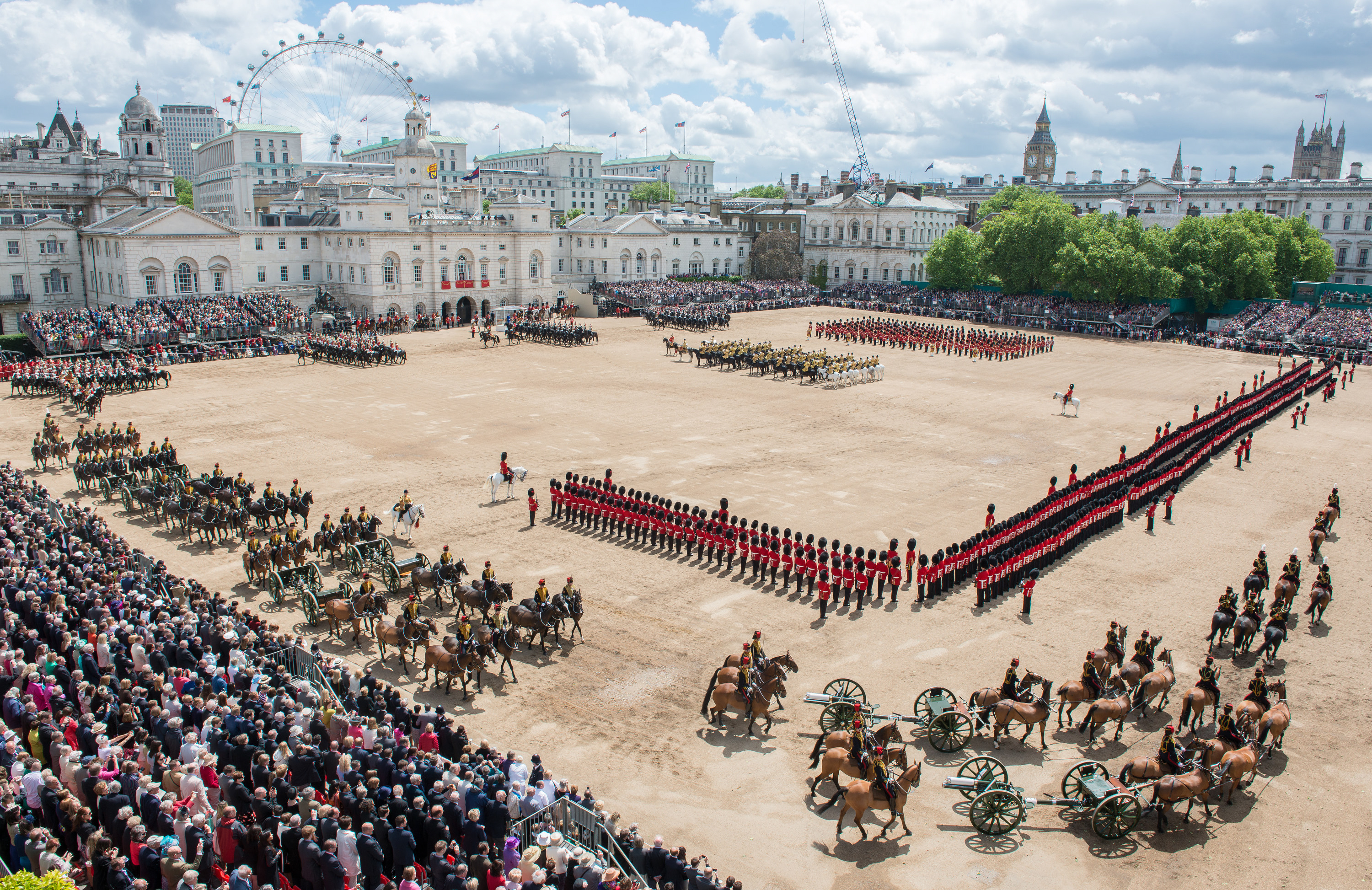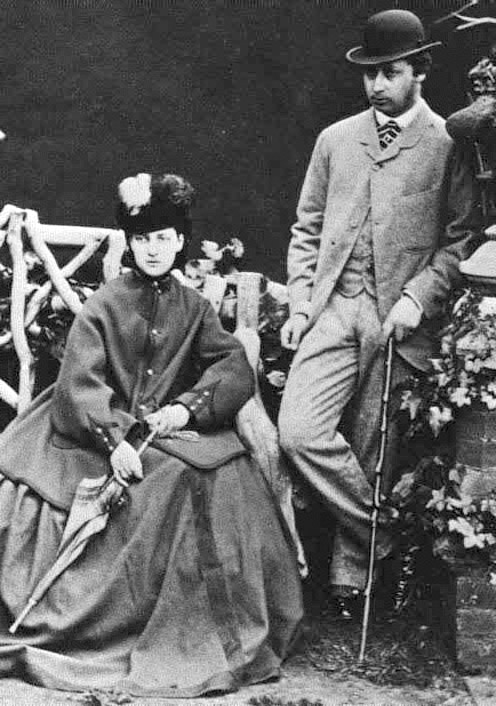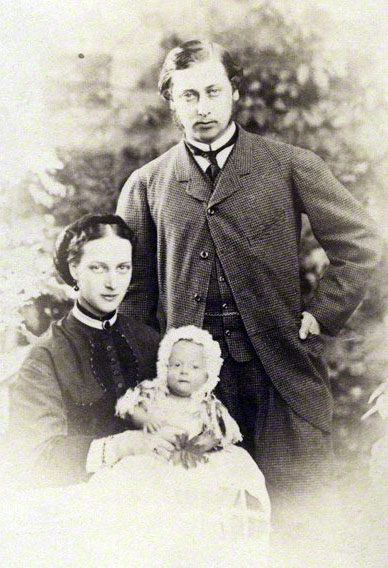|
Trooping Of The Colour
Trooping the Colour is a ceremonial event performed every year on Horse Guards Parade in London, United Kingdom, by regiments of Household Division, to celebrate the official birthday of the British sovereign, though the event is not necessarily held on that day. It is also known as the Sovereign's Birthday Parade. Similar events are held in other countries of the Commonwealth. In the UK, it is, with the State Opening of Parliament, the biggest event of the ceremonial calendar, and watched by millions on TV and on the streets of London. Historically, colours were once used on the battlefield as a rallying point. They display the battle honours of a regiment and are a focal point of Trooping the Colour. The ceremony has marked the sovereign's official birthday since 1748. Each year, one of the five Foot Guards regiments of the Household Division is selected to slowly troop (carry) its colour through the ranks of guards, who stand with arms presented. During the slow march-past, ... [...More Info...] [...Related Items...] OR: [Wikipedia] [Google] [Baidu] |
Gun Salute
A gun salute or cannon salute is the use of a piece of artillery to fire shots, often 21 in number (''21-gun salute''), with the aim of marking an honor or celebrating a joyful event. It is a tradition in many countries around the world. History Firing cannons is a maritime tradition that dates back to the 14th century, when the cannon began to impose itself on the battlefields: a boat entering the waters of a country unloads its weapons and thus marks its intentions as peaceful. The coastal batteries or the boats encountered then respond to this salute. If 7 cannon shots are fired at the start, corresponding to the number of guns on board a boat, in addition to the symbolism of the number seven, this number increases to 21, since it was considered that for a shot fired by a boat, the batteries on land had enough powder for three rounds. 21-gun salute Other numbered salutes To honor the 75th birthday of Charles III, King Charles III, a number of special salutes were fired ... [...More Info...] [...Related Items...] OR: [Wikipedia] [Google] [Baidu] |
Birthday Honours
The Birthday Honours, in some Commonwealth realms, mark the reigning monarch's official birthday in each realm by granting various individuals appointment into national or dynastic orders or the award of decorations and medals. The honours are presented by the monarch or a viceregal representative. The Birthday Honours are one of two annual honours lists, along with the New Year Honours. All royal honours are published in the relevant gazette. History Honours have been awarded with few exceptions on the sovereign's birthday since at least 1860, during the reign of Queen Victoria. There was no Birthday Honours list issued in 1876, which brought "a good deal of disappointment" and even rebuke for the Ministry of Defence. A lengthy article in the ''Broad Arrow'' newspaper forgave the Queen and criticised Gathorne Hardy for neglecting to award worthy soldiers with the Order of the Bath: "With the War Minister all general patronage of this description rests, and if Mr. Hardy has n ... [...More Info...] [...Related Items...] OR: [Wikipedia] [Google] [Baidu] |
Edward VII
Edward VII (Albert Edward; 9 November 1841 – 6 May 1910) was King of the United Kingdom and the British Dominions, and Emperor of India, from 22 January 1901 until Death and state funeral of Edward VII, his death in 1910. The second child and eldest son of Queen Victoria and Prince Albert of Saxe-Coburg and Gotha, Edward, nicknamed "Bertie", was related to royalty throughout Europe. He was Prince of Wales and heir apparent to the British throne for almost 60 years. During his mother's reign, he was largely excluded from political influence and came to personify the fashionable, leisured elite. He Wedding of Prince Albert Edward and Princess Alexandra, married Princess Alexandra of Denmark in 1863, and the couple had six children. As Prince of Wales, Edward travelled throughout Britain performing ceremonial public duties and represented Britain on visits abroad. His tours of North America in 1860 and of the Indian subcontinent in 1875 proved popular successes. Despite the ap ... [...More Info...] [...Related Items...] OR: [Wikipedia] [Google] [Baidu] |
Windsor Castle
Windsor Castle is a List of British royal residences, royal residence at Windsor, Berkshire, Windsor in the English county of Berkshire, about west of central London. It is strongly associated with the Kingdom of England, English and succeeding British royal family, and embodies almost a millennium of architectural history. The original castle was built in the 11th century, after the Norman invasion of England by William the Conqueror. Since the time of Henry I of England, Henry I (who reigned 1100–1135), it has been used by the reigning monarch and is the longest-occupied palace in Europe. The castle's lavish early 19th-century state apartments were described by the art historian Hugh Roberts (art historian), Hugh Roberts as "a superb and unrivalled sequence of rooms widely regarded as the finest and most complete expression of later Georgian taste".Hugh Roberts, ''Options Report for Windsor Castle'', cited Nicolson, p. 79. Inside the castle walls is the 15th-ce ... [...More Info...] [...Related Items...] OR: [Wikipedia] [Google] [Baidu] |
Queen Victoria
Victoria (Alexandrina Victoria; 24 May 1819 – 22 January 1901) was Queen of the United Kingdom of Great Britain and Ireland from 20 June 1837 until Death and state funeral of Queen Victoria, her death in January 1901. Her reign of 63 years and 216 days, which was List of monarchs in Britain by length of reign, longer than those of any of her predecessors, constituted the Victorian era. It was a period of industrial, political, scientific, and military change within the United Kingdom of Great Britain and Ireland, United Kingdom, and was marked by a great expansion of the British Empire. In 1876, the British parliament voted to grant her the additional title of Empress of India. Victoria was the daughter of Prince Edward, Duke of Kent and Strathearn (the fourth son of King George III), and Princess Victoria of Saxe-Coburg-Saalfeld. After the deaths of her father and grandfather in 1820, she was Kensington System, raised under close supervision by her mother and her Comptrol ... [...More Info...] [...Related Items...] OR: [Wikipedia] [Google] [Baidu] |
Prince Albert Victor, Duke Of Clarence
Prince Albert Victor, Duke of Clarence and Avondale (Albert Victor Christian Edward; 8 January 1864 – 14 January 1892) was the eldest child of the Prince and Princess of Wales (later King Edward VII and Queen Alexandra). From the time of his birth, he was second in the line of succession to the British throne, but did not become king or Prince of Wales because he died before both his father and paternal grandmother Queen Victoria. Albert Victor was known to his family, and many later biographers, as "Eddy". When he was young, he travelled the world extensively as a Royal Navy cadet, and as an adult, he joined the British Army, but did not undertake any active military duties. After two unsuccessful courtships, he became engaged to be married to his second cousin once removed Princess Victoria Mary of Teck in late 1891. A few weeks later, he died during a major pandemic. Mary later married his younger brother, the future King George V. Albert Victor's intellect, sexuality, a ... [...More Info...] [...Related Items...] OR: [Wikipedia] [Google] [Baidu] |
Prince George, Duke Of Cambridge
Prince George, Duke of Cambridge (George William Frederick Charles; 26 March 1819 – 17 March 1904) was a member of the British royal family, a grandson of King George III and cousin of Queen Victoria. The Duke was an army officer by profession and served as Commander-in-Chief of the Forces (military head of the British Army) from 1856 to 1895. He became Duke of Cambridge in 1850 and Field marshal (United Kingdom), field marshal in 1862. Deeply devoted to the old Army, he worked with Queen Victoria to defeat or minimise every reform proposal, such as setting up a Staff (military), general staff. His Army's weaknesses were dramatically revealed by the poor organisation at the start of the Second Boer War. Early life Prince George was born at Cambridge House, Hanover.Heathcote, p. 141 His father was Prince Adolphus, Duke of Cambridge, the seventh son of King George III and Charlotte of Mecklenburg-Strelitz, Queen Charlotte. His mother was the Duchess of Cambridge (née Princess ... [...More Info...] [...Related Items...] OR: [Wikipedia] [Google] [Baidu] |
George III
George III (George William Frederick; 4 June 173829 January 1820) was King of Great Britain and King of Ireland, Ireland from 25 October 1760 until his death in 1820. The Acts of Union 1800 unified Kingdom of Great Britain, Great Britain and Kingdom of Ireland, Ireland into the United Kingdom of Great Britain and Ireland, with George as its king. He was concurrently Duke and Prince-elector of Electorate of Hanover, Hanover in the Holy Roman Empire before becoming King of Hanover on 12 October 1814. He was the first monarch of the House of Hanover who was born in Great Britain, spoke English as his first language, and never visited Hanover. George was born during the reign of his paternal grandfather, George II of Great Britain, King George II, as the first son of Frederick, Prince of Wales, and Princess Augusta of Saxe-Gotha. Following his father's death in 1751, Prince George became heir apparent and Prince of Wales. He succeeded to the throne on George II's death in 1760. Th ... [...More Info...] [...Related Items...] OR: [Wikipedia] [Google] [Baidu] |
Charles II Of England
Charles II (29 May 1630 – 6 February 1685) was King of Scotland from 1649 until 1651 and King of England, Scotland, and King of Ireland, Ireland from the 1660 Restoration of the monarchy until his death in 1685. Charles II was the eldest surviving child of Charles I of England, Scotland and Ireland and Henrietta Maria of France. After Charles I's execution at Palace of Whitehall, Whitehall on 30 January 1649, at the climax of the English Civil War, the Parliament of Scotland proclaimed Charles II king on 5 February 1649. However, England entered the period known as the English Interregnum or the English Commonwealth with a republican government eventually led by Oliver Cromwell. Cromwell defeated Charles II at the Battle of Worcester on 3 September 1651, and Charles Escape of Charles II, fled to mainland Europe. Cromwell became Lord Protector of England, Scotland and Ireland. Charles spent the next nine years in exile in France, the Dutch Republic and the Spanish Netherlands. ... [...More Info...] [...Related Items...] OR: [Wikipedia] [Google] [Baidu] |







